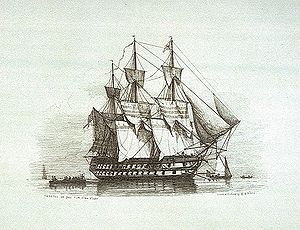French ship Franklin (1797)
 |
|
| History | |
|---|---|
|
|
|
| Name: | Franklin |
| Namesake: | Benjamin Franklin |
| Builder: | Toulon |
| Laid down: | November 1794 |
| Launched: | 25 June 1797 |
| Completed: | By March 1798 |
| Captured: | 2 August 1798, by the Royal Navy |
|
|
|
| Name: | HMS Canopus |
| Acquired: | 2 August 1798 |
| Fate: | Sold for breaking up in October 1887 |
| General characteristics | |
| Class and type: | 84-gun third rate ship of the line |
| Tons burthen: | 2,258 77/94 bm |
| Length: |
|
| Beam: | 51 ft 6.75 in (15.7 m) |
| Depth of hold: | 23 ft 4.5 in (7.12 m) |
| Propulsion: | Sails |
| Sail plan: | Full rigged ship |
| Complement: | 700 |
| Armament: |
|
HMS Canopus was an 84-gun third rate ship of the line of the British Royal Navy. She had previously served with the French Navy as the Tonnant-class Franklin, but was captured after less than a year in service by the British fleet under Rear Admiral Horatio Nelson at the Battle of the Nile in 1798. Having served for less than six months for the French from her completion in March 1798 to her capture in August that year, she would eventually serve for 89 years for the British.
Her career began as the flagship of Rear-Admiral Armand Blanquet du Chayla, second in command at the Battle of the Nile, where she distinguished herself with her fierce resistance before being forced to surrender with over half her crew dead or wounded, and most of her guns disabled. Taken into British service she was refitted and served as the flagship of several admirals. Commanded by Francis Austen Canopus was Rear-Admiral Thomas Louis's flagship in the Mediterranean under Nelson, and narrowly missed the fighting at Trafalgar. She saw action with Duckworth's fleet at the Battle of San Domingo, and remained with him during the attempt to force the Dardanelles, and the operations in support of the Alexandria expedition in 1807. She remained active against the French in the Mediterranean for the rest of the Napoleonic Wars, helping to drive ashore two large French ships of the line in a notable incident in 1809. Canopus remained in service after the end of the wars, serving as a flagship into the mid-nineteenth century, but as sail gave way to steam, she was relegated to support duties in Devonport, becoming a receiving ship, tender and a mooring hulk. She was eventually sold for breaking up in 1887, after nearly ninety years in British service.
...
Wikipedia
